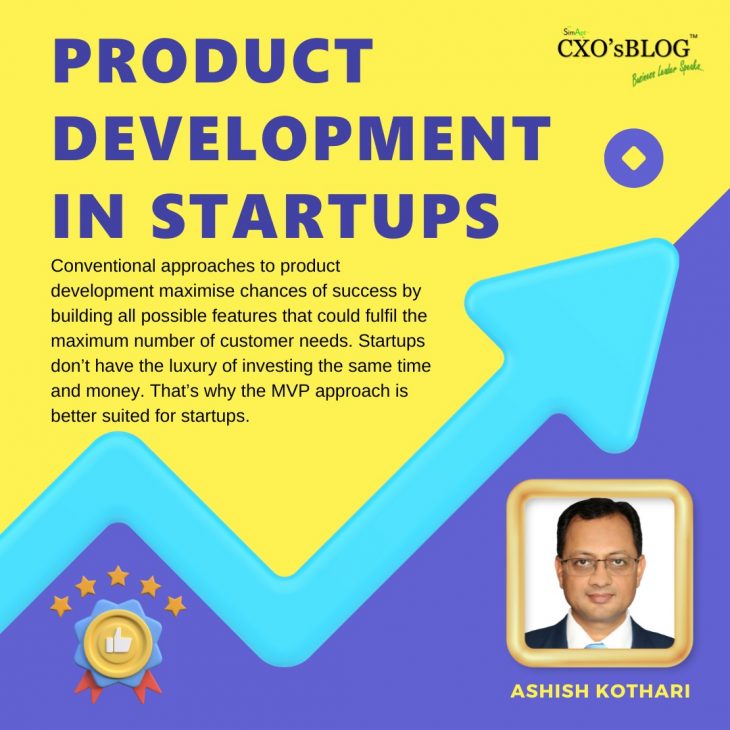Author: Ashish Kothari
Conventional approaches to product development maximise chances of success by building all possible features that could fulfil the maximum number of customer needs. Startups don’t have the luxury of investing the same time and money. That’s why the MVP approach is better suited for startups.
What’s the most difficult job in the world? The answers to could range from Astronaut, Bomb Disposal Technician, Construction Worker, Diver – and the list could go on. I wouldn’t be surprised if “Startup Founder” ranked somewhere at the top of that list.
The primary focus of early stage startups is on translating a brilliant idea into a usable product or service. If you’re one of those founders who have spent a good part of your career working for a large company, and now decided to take the plunge, then you will know that the investment involved in bringing a new product or service to market comes as much from educating, marketing and selling to people to change embedded habits and behaviour, as it does from product development and manufacturing. That’s why startups should narrowly focus on launching a Minimum Viable Product (MVP). There’ll be time enough for scaling up and expanding into more product-market segments in due course.
In an earlier article, I wrote about the STP process, which is fundamental and integral to product development. But when it comes to startups, they are likely to lack the resources and time for this exhaustive approach, and may be better advised to take an “MVP” approach.
So, what exactly is an MVP?
An MVP is the most basic version of a product that can be launched in the market. Unlike a prototype, it is a fully working product that consumers will typically pay for and use. A key difference with products launched by large corporations is the narrow focus on one (or the least possible) segment and minimal product features. Within the narrow focus and limited functionality, it is still a rigorously designed and high-quality product. In fact, a low-quality MVP for test marketing the product is more likely to hurt the chances of the idea or concept catching on.
Remember the iPod? A “simple” device that quickly killed MP3 players, yet didn’t have all the bells and whistles that ultimately made the concept transition into the iPhone. What if the iPod hadn’t succeeded, would Apple have invested in the iPhone? And imagine if Apple had started off directly with introducing a technological (and certification heavy) product, the iPhone, without securing loyalists through the iPod. They would have had to invest heavily in changing business users (BlackBerry, Palm) by taking them head-on, besides the investment in the technology.
An MVP need not refer to physical products alone; it may equally be an app or a service. Digital services are best suited for the MVP approach. MVP’s help to acquire early adopters, and startups should capture their feedback to guide future product enhancements and evolution.
The MVP approach differs from the conventional marketing strategy of investing significant time and money upfront to target the whole market. It ensures that the market wants the product before putting in such investments; and that the initial product continues to evolve based on what the market wants. Steve Blank, one of the early proponents of MVP, said, “You’re selling the vision and delivering the minimum feature set to visionaries, not everyone”. The aim is to reduce the hours spent on engineering, and to get the product into the hands of the visionary customer, the early evangelist.
Let’s take a look at some successful startups.
- In 2000, MakeMyTrip was first launched in USA to provide NRIs with America-India trips. Notice the narrow product-market focus. In 2005, it launched its office in India, for booking flight tickets. MMT then went on to offer domestic and international holiday packages, hotel reservations, rail and bus tickets, and more. From a single idea of empowering the traveller, MMT gradually scaled up the MVP to become a comprehensive online travel company.
- FreeCharge started out in 2010 with its core offer of mobile recharges, with free vouchers from retailers for an equivalent value. It has since integrated with other services including DTH, data cards, electricity, gas, water, landline, and broadband – thereby evolving into a digital payment platform. FreeCharge is also accepted at many online and offline retailers.
- Ola Cabs was started by IIT-B graduates Ankit Bhati and Bhavish Aggarwal in 2010, after a bad experience with a rented cab. Together, they launched a service in Mumbai, offering convenience and transparent pricing. Ola now offers services in 250+ cities across India, Australia, New Zealand, and the UK. The service extends to a wide range of vehicles including bikes, auto-rickshaws, metered taxis, and cabs. Ola has further expanded into electric vehicles, fleet management, scooter sharing. All these offers are driven by one mission: to build mobility for a billion people.
Let’s get back to our startup. As with most startups, funding will be the key to setting up the business. Whether the entrepreneur secures funding through venture capital firms or angel investors, whether they go through an accelerator or incubator, there’s one thing they can be sure of. They will be making a pitch to investors at demo day.
Demo day is when startups pitch their business to a room full of investors, in the hope of securing investment. This may represent the startups seed round or Series A round of funding. The MVP is core to demo day. Investors will want evidence that the product will succeed. This is very different from an established corporation launching a new product, where the investment is supported by approved budgets and business plans. Therefore, to get the investment, founders are well advised to adopt the MVP approach.
